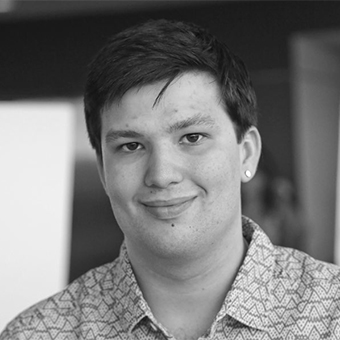Aaron Ammerman
 M.R. Bauer Foundation Summer Science Research Fellow
M.R. Bauer Foundation Summer Science Research Fellow
Oprian Laboratory
Department of Biochemistry
Brandeis University
Spectral Tuning of an Opsin-Guanylyl Cyclase Fusion Protein for Optogenetic Use
Poster Abstract
Rho-GC (bacteriorhodopsinguanylyl cyclase) is a fusion protein responsible for phototaxis in the fungus Blastocladiella emersonii. We are researching Rho-GC for use as an optogenetic tool. We wish to move expression into adult flies to show function as an optogenetic tool. Wild type Rho-GC absorbs green light, which would not penetrate the cuticle of an adult fly (meaning the protein would not be activated). We investigated methods to spectrally tune Rho-GC from a green absorption maximum to red to make the protein sensitive to deeper penetrating light. The binding pocket of bacteriorhodopsins comprises three key residues: Lys 216, Asp 85, and Asp 212. Lys 216 binds covalently to retinal by means of a protonated Schiff base linkage, while Asp 85 and Asp 212 serve as counterions to the positively charged nitrogen. Past studies with microbial rhodopsins have found that changing these counterion residues, as well as other residues involved in retinal binding, can result in color shifts. With this in mind, mutations were designed at analog residues in Rho-GC, yielding three spectral tuning mutants: E254D, D380N (both blue shifted mutants), and D380E (a red shifted mutant). Further experiments are necessary to determine new residues to mutate as well as to test the activity of all spectral tuning mutants.
Personal Statement
My time working in the Oprian lab with the funding of the M.R. Bauer Foundation has been absolutely incredible. While this summer of research has helped me develop more lab autonomy by improving my time management and research skills, the biggest impact this summer has had on me was teaching me how to cope with a difficult project. This summer, I found many of my experiments constrained by long reaction times and more unfavorable results than favorable ones. It forced me to face a hard truth: Sometimes you can spend a month on an experiment only to find that it was destined to fail. I began to view my project like a maze: There’s only a few correct paths to the center, but a lot of forks in the road leading to false paths with dead ends. This summer had a lot of dead ends. But when I reached a dead end, I did not give up. Instead, I tried to determine why an experiment failed and if there was anything I could do to make the experiment successful. If I could not fix the experiment, then I moved on. I read papers, went to talks, and tried to find a new angle to approach my object. When my efforts gave me a new idea or experiment for my project, I found my PI and coworkers extremely supportive in helping implement my ideas and getting results. I do not know where my project’s current path will take me, nor do I know how many more twists and turns are ahead. But I am excited to walk the path, and grateful to the M.R. Bauer Foundation for the opportunity to do so.